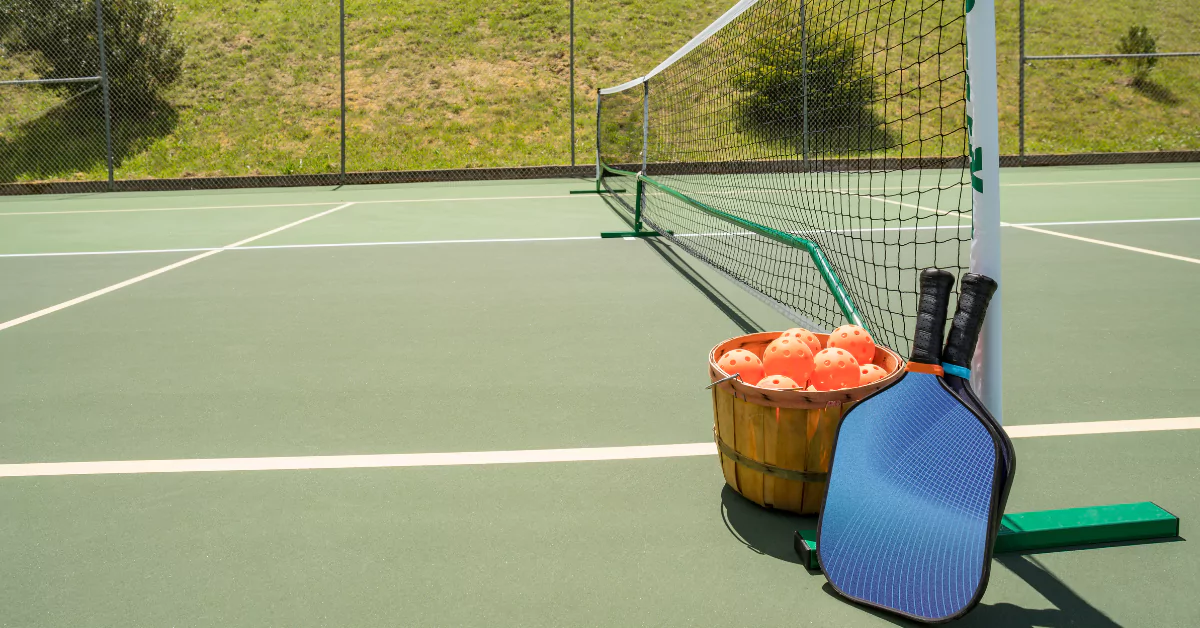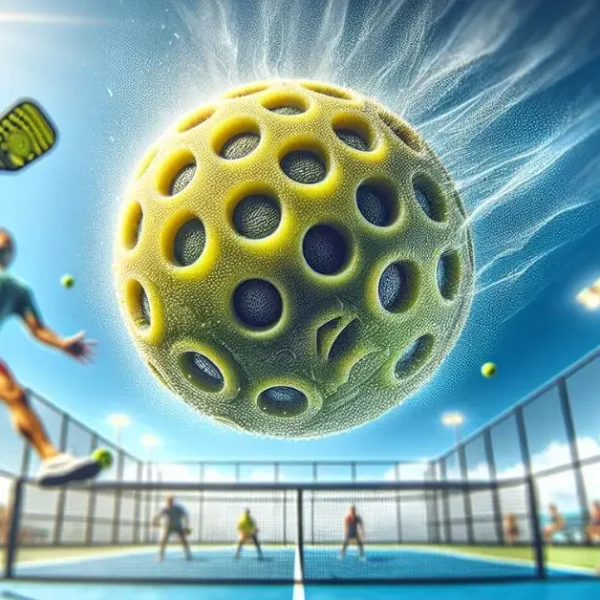I’ve had the opportunity to cover several sports and their respective courts. However, in this article, I will be focusing on two popular racquet sports, pickleball, and tennis, and conducting a comparative analysis of their courts.
Pickleball and tennis might seem similar at first glance, but they have distinct differences that affect the game’s pace and strategies used by players. By understanding these differences, facility owners and players can make informed decisions about which sport and court are best suited for their needs.
Key Takeaways
- Pickleball and tennis courts have different dimensions and surface materials.
- The gameplay of pickleball and tennis differs regarding rules, scoring system, equipment used and pace of the game.
- Building a pickleball or tennis court requires specific construction processes, materials, and regulations.
Pickleball Vs Tennis Courts: Which One Is Best For You?
Dimensions of Pickleball Court vs Tennis Court
The dimensions of a pickleball court and a tennis court are significant factors that determine the gameplay experience for players. While both courts are rectangular in shape, their sizes differ markedly. A tennis court measures 78 feet in length and 27 feet in width for singles matches, and 36 feet in width for doubles matches. In contrast, a pickleball court measures only 44 feet in length and 20 feet in width, making it roughly half the size of a tennis court.
| Tennis Court | Pickleball Court | |
|---|---|---|
| Length | 78 feet | 44 feet |
| Width – singles matches | 27 feet | 20 feet |
| Width – doubles matches | 36 feet | 20 feet |
The smaller size of a pickleball court can offer several advantages to players, including a quicker pace of play, more frequent physical movements, and shorter reaction times. Moreover, the smaller court size makes pickleball more accessible for beginners, seniors, and players with limited mobility or physical disabilities.
However, the smaller size of a pickleball court can also pose some challenges, such as reduced space for players to move around and fewer opportunities for strategic plays. In contrast, a tennis court’s larger size can provide more opportunities for long rallies, a wider range of shot selections, and greater flexibility in positioning and tactics. However, the larger court size can also result in longer matches, more demanding physical exertion, and a steeper learning curve for novice players.
Official Dimensions And Layout Of Court
Surfaces of Pickleball Court vs Tennis Court
The surface of a court is an essential factor that can drastically alter the gameplay experience for pickleball and tennis players. Whereas tennis courts are typically made of asphalt or concrete, pickleball courts are often constructed with a variety of surface materials, including synthetic turf, carpet, and even hardwood.
The nature of the surface affects the movement of the ball, the agility of the players, and the speed of the game. On a hard court, such as those used in tennis, the ball can bounce faster and higher, making it more challenging for players to keep up, especially if the ball bounces irregularly. In contrast, pickleball courts with softer surfaces can slow down the ball, making it easier for players to get to the ball in time and return it.
Another critical aspect to consider is the maintenance required for each surface type. Hard courts can be more durable and require less upkeep than softer surfaces, but can be more challenging to repair if they crack or develop potholes. Meanwhile, softer surfaces, like those made of synthetic turf, can provide better shock absorption and injury prevention, but may require significant maintenance to keep the surface in good playing condition.
Gameplay Comparison: Pickleball vs Tennis
While both pickleball and tennis are racket sports, they differ significantly in terms of gameplay. Let’s take a closer look at each sport’s rules, scoring system, and equipment used.
Pickleball
In pickleball, players use a paddle to hit a plastic ball over a net. The game is played on a smaller court, which is roughly one-third the size of a tennis court. The game can be played in singles or doubles.
The serve must be hit underhanded, and the ball must land within the opponent’s court. Only the serving team can score points, and a point is awarded when the opponent fails to return the ball or hits the ball out of bounds. The first team to reach 11 points, with a lead of at least two points, wins the game.
Players typically use lightweight paddles made of materials such as wood, graphite, or composite. The ball used in pickleball is slightly larger and slower than a tennis ball, making it easier to control and allowing for longer rallies.
Tennis
In tennis, players use a racket to hit a felt-covered ball over a net. The game is played on a larger court and can be played in singles or doubles.
The serve can be hit overhand or underhanded, and the ball must land within the opponent’s court. Both the serving and receiving team can score points, and a point is awarded when the opponent fails to return the ball or hits the ball out of bounds. The first player or team to reach at least four points, with a lead of at least two points, wins the game. A full match is typically played best-of-three or best-of-five sets, depending on the competition level.
Players typically use heavier rackets made of materials such as graphite or carbon fiber. The ball used in tennis is smaller and faster than a pickleball, requiring greater skill and accuracy to control during play.
Overall, while both sports require similar skills such as hand-eye coordination and quick reflexes, pickleball is generally considered a more accessible and beginner-friendly sport due to its smaller court size and slower ball speed. Tennis, on the other hand, is a more challenging and physically demanding sport that requires greater stamina and endurance.
Pickleball Vs Tennis: Why Is Pickleball Easier Than Tennis?
Construction of Pickleball Court vs Tennis Court
Building a pickleball court versus a tennis court requires different considerations. While the overall layout of the court may appear similar, the dimensions, materials, and construction process vary.
Pickleball courts are smaller than tennis courts, measuring 20 feet wide by 44 feet long, while tennis courts are typically 36 feet wide by 78 feet long. The surface of a pickleball court is also different, with the most common being made of concrete or asphalt with a textured coating. Tennis courts often have a harder surface, such as a synthetic turf or a porous concrete surface.
The materials used to construct the court also differ. For a pickleball court, the surface is laid over a compacted gravel or stone base, and then painted with the required court lines. Tennis courts, on the other hand, require a thicker base of crushed stone, which is then covered with asphalt or concrete before the court surface is applied.
When building either type of court, it is important to follow specific regulations and guidelines to ensure that the court is safe and suitable for the sport. These can include requirements for proper drainage, slope dimensions, and boundary lines. A professional contractor with experience in building both types of courts can help ensure that all regulations are met and the court is constructed to the highest standards.
Conclusion
After comparing and analyzing the differences between pickleball courts and tennis courts, it is clear that these two sports have distinct characteristics and requirements. While both sports involve hitting a ball over a net, the dimensions, surfaces, and gameplay are quite different, which has an impact on the strategies and techniques used by players.
For those considering building a court, it is important to take into account the space available, the budget, and the intended use of the court. Pickleball courts are smaller in size and require less space and equipment compared to tennis courts, making them a more accessible option for recreational players. However, if the intention is to host high-level competitions or tournaments, a full-size tennis court may be more suitable.
Furthermore, the type of surface can significantly impact the player experience and maintenance requirements. While both asphalt and concrete are common materials used for both types of courts, synthetic grass or turf can also be used to simulate the feel of a grass court. Each surface has its advantages and disadvantages, and the choice ultimately depends on personal preferences and practical considerations.
In conclusion, both pickleball and tennis offer unique and enjoyable experiences for players of all levels. The growing popularity of pickleball has sparked interest in this relatively new sport, and it will be interesting to see how it develops and impacts the tennis industry. Whether you choose to play pickleball or tennis, what matters most is the love for the game and the joy of playing.
FAQ
Q: What are the main differences between a pickleball court and a tennis court?
A: The main differences between a pickleball court and a tennis court lie in their dimensions, surfaces, and gameplay. Pickleball courts are smaller than tennis courts and have different dimensions. The surfaces of the two courts also differ, with pickleball courts often being made of asphalt or concrete, while tennis courts can be made of various materials such as asphalt, concrete, or synthetic turf. Additionally, the gameplay of pickleball and tennis varies in terms of rules, scoring systems, equipment used, and overall pace of the game.
Q: What are the dimensions of a pickleball court and a tennis court?
A: The dimensions of a pickleball court are 20 feet wide by 44 feet long for both singles and doubles play. On the other hand, a tennis court is 27 feet wide for singles play and 36 feet wide for doubles play. The length of a tennis court is 78 feet.
Q: What kind of surfaces are used for pickleball courts and tennis courts?
A: Pickleball courts are typically made of asphalt or concrete, offering a solid and durable surface for gameplay. Tennis courts, on the other hand, can be made of various materials such as asphalt, concrete, or synthetic turf. Each type of surface has its own characteristics and impact on gameplay.
Q: How does the gameplay of pickleball differ from tennis?
A: The gameplay of pickleball and tennis differs in several ways. Pickleball has its own set of rules and scoring system, which are different from those of tennis. The size of the court is also smaller in pickleball, requiring different strategies and techniques. Additionally, the type of racket used in each sport differs, with pickleball utilizing a paddle and tennis using a stringed racket.
Q: What is involved in the construction of a pickleball court or a tennis court?
A: The construction process for pickleball courts and tennis courts involves several steps, materials, and considerations. The necessary steps may include site preparation, marking and measuring the court dimensions, excavation, installation of the base and surface materials, and line painting. The specific materials used may vary depending on factors such as budget, location, and desired court performance. It is important to also consider any regulations or guidelines that may need to be followed for constructing a court suitable for pickleball or tennis.


